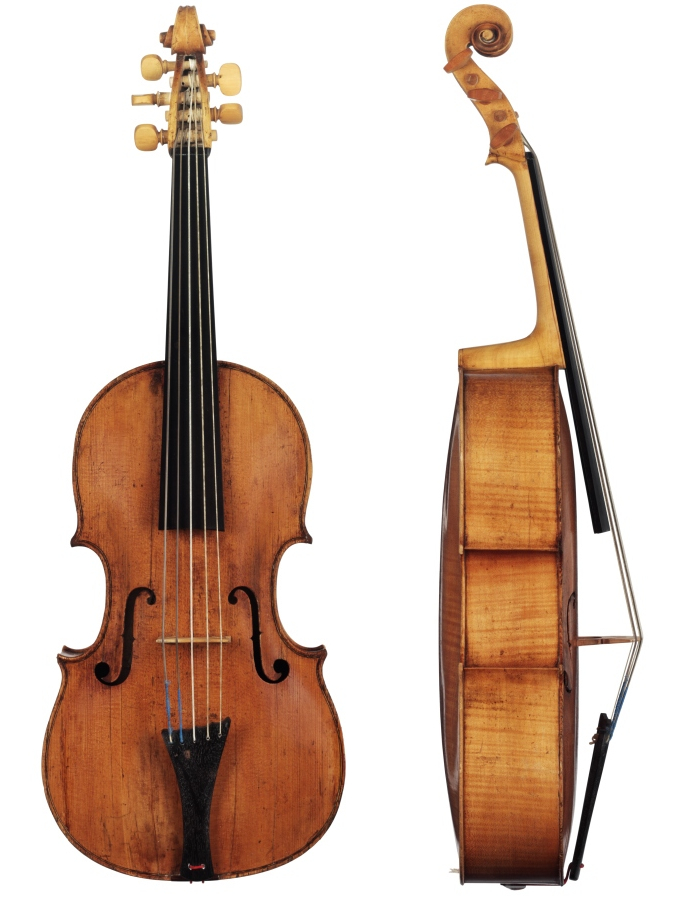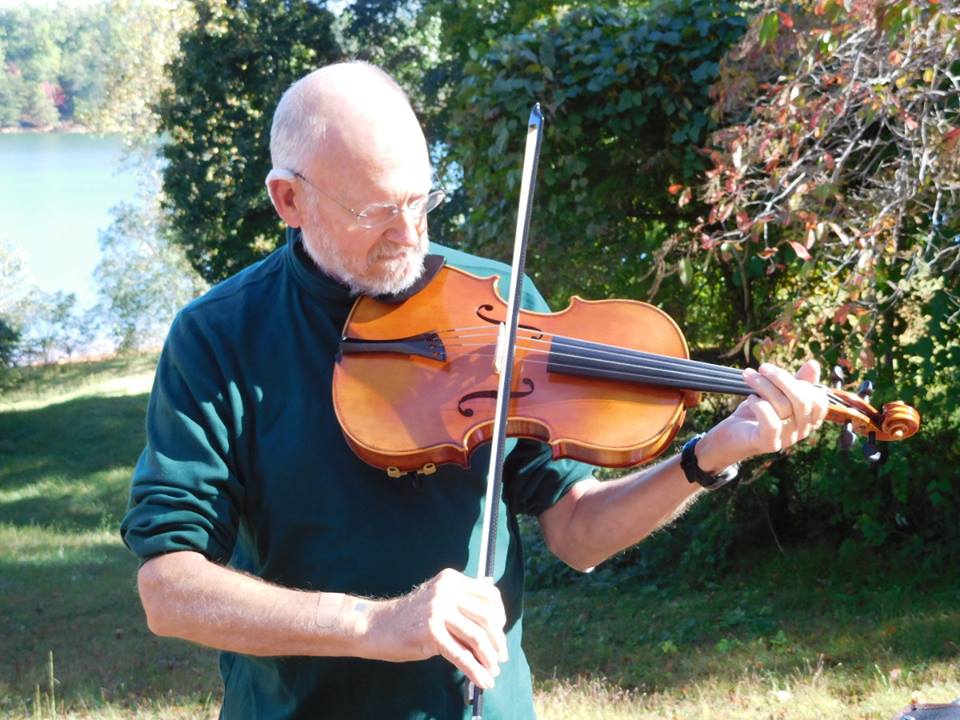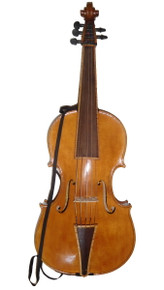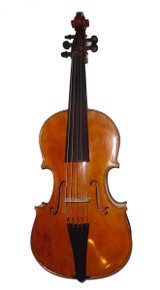Categories
Categories
- Home
- Baroque Instruments (including pochettes)
- NEW Violoncello da Spalla by D. Rickert (Standard Plus Model)
NEW Violoncello da Spalla by D. Rickert (Standard Plus Model)
NEW Violoncello da Spalla by D. Rickert (Standard Plus Model)
Product Description
Please contact us if you wish to discuss purchasing one of these fine instruments.
Our email is don@DonRickertDesign.com and phone number is (706) 896-0909 or (706) 400-1481 (mobile). You can also use the "Contact" link on this page.
Violoncello da Spalla Standard Plus Model by D. Rickert
This exciting new model replaces our popular Standard Model. The base price for the new Violoncello da Spalla Standard Plus is $16,500. If you are looking for a Violoncello da Spalla for just over $10,000, we will still do a few more of the Standard Model for those who are ready to purchase now.
See and hear some demonstrations of our Violoncellos da Spalla.
The demonstrations below are but two of a large and growing number that can be seen and heard on our Violoncello da Spalla Demo Page.
The incredible Andrew Gonzalez performing on our Violoncello da Spalla by Don Rickert.
Heifetz 2018: Violoncello da spalla | Andrew Gonzalez Plays Bach
Bach 6th Suite Gigue on Violoncello da Spalla
Introduction
 After receiving inquiries about violoncellos da spalla for several years, we started making them on a custom basis in 2017, Due to their extreme popularity, we have making them on a regular basis since 2018. Production was running at up to 6 a year. We have determined that the market for violoncellos da spalla has evolved such that most actual buyers are interested in the more expensive close-to-100% master-built (i.e., minimal apprentice or contract labor) instruments. We also make octave violins, 5-string violins, octave mezzo violins and our high-end travel violins. Starting in 2022, we have been making a few high-end octave mandolins, citterns and mandocellos, which are on par with our violoncellos da spalla and other violin-family instruments.
After receiving inquiries about violoncellos da spalla for several years, we started making them on a custom basis in 2017, Due to their extreme popularity, we have making them on a regular basis since 2018. Production was running at up to 6 a year. We have determined that the market for violoncellos da spalla has evolved such that most actual buyers are interested in the more expensive close-to-100% master-built (i.e., minimal apprentice or contract labor) instruments. We also make octave violins, 5-string violins, octave mezzo violins and our high-end travel violins. Starting in 2022, we have been making a few high-end octave mandolins, citterns and mandocellos, which are on par with our violoncellos da spalla and other violin-family instruments.
We now offer one model of full-size (i.e. 18" body) Violoncello da Spalla:
- Violoncello da Spalla Standard Plus (Starting at $16,500)
- This instrument has the same basic specifications as the Standard Model, but is hand-made by Master luthier, Dr. Donald Rickert in our workshop in Hiawassee, GA, USA, with minimal apprentice or contract labor. At the buyers request. authenticity of provenance can be assured by an NFT (Non Fungible Token), in the form of a micro-chip built into the instrument during construction. The technology of how this works is way beyond the scope of this product description. An "old school" physical notarized certificate of provenance is also provided.
Our Violoncello da Spalla Standard Plus is the model described here. The instrument being played in the above demos is the Standard Model. It is essentially a replica of an 18” violoncello da spalla after the famous instrument (1732) by Johann Christian Hoffman pictured here. This 5-string instrument is powerful and sonorous, regardless of whether it is strung with modern strings, gut strings or a mix, such as gut for the high three with modern lower two strings.
Background: What is a Violoncello da Spalla?
The violoncello da spalla (Italian for “cello of the shoulder”) was, until fairly recently, a 5-string instrument of the violin family from the Baroque period that had fallen into obscurity. It is a small instrument, about the size of a modern 1/10 size cello, that is tuned to C, G, d, a, e’ (i.e. like a cello with an additional string on the treble side that is tuned to e’, which is an octave lower than the e” string on a violin)
It is thought by many that the violoncello da spalla was invented, or at least perfected, in the early 1700s. A now well-documented and widely-replicated instrument was made in 1732 by the German luthier, Johann Christian Hoffman, a contemporary and thought to be a close friend of Johann Sebastian Bach. Bach’s purported close relationship with J. C. Hoffmann has led to a now popular theory that Bach had a hand in the invention of the violoncello da spalla. This belief continues to be debated by experts who study the history of musical instruments. Other less well-documented instruments now considered to be early versions of violoncellos da spalla (in today's parlance anyway) were made in the 1600s. None of these instruments were called "violoncello da spalla" when they were new; well, probably not.
Anyway, what is now widely regarded as the primary candidate for distinction as the original actual violoncello da spalla, rather than just a large 5-string viola, having been previously classified as either a viola pomposa, viola da spalla or piccolo cello, was made in 1732 by Hoffmann. It is this instrument that, today, is the de facto “gold standard” for a proper violoncello da spalla. Most contemporary makers replicate at least the principle measurements of the Hoffmann instrument. Most builders that I know of apply knowledge gained in the past 300 years to things like the bass bar, tap tones and the like.
The modern resurrection of the violoncello da spalla, and widespread attribution of the instrument’s invention to Hoffmann, is due largely to the Russian-Dutch luthier and media celebrity, Dmitry Badiarov. Badiarov, based in The Hague, introduced his first violoncello da spalla in 2004, essentially after Hoffmann, albeit, considerably more refined, in my opinion, than the original 1732 instrument. While Badiarov, and his collaborator, Sigiswald Kuijken, are more well-known, it was earlier research by the Dutch violinist and violist, Lambert Smit, that laid the groundwork for Badiarov and others involved in the resurgence of the violoncello da spalla. Smit is regarded by many as maybe the the grandfather (with Badiarov the father maybe?) of the modern revival of the violoncello da spalla. No one can deny Badiarov the distinction of original Violoncello da Spalla Evangelist! But, it was Smit who first posited the involvement of Bach, himself, in its invention. It was Smit who surmised that Bach’s Cello Suites and Cantatas were written, not for the full-size 4-string cello, but rather for the much smaller 5-string violoncello da spalla.
Since 2004, the violoncello da spalla has grown exponentially in popularity, largely due to Badiarov’s tireless ongoing research, teaching and relentless promotion. He also has made quite a few of these unique and very cool instruments for world-famous musicians.
How is the Violoncello da Spalla played?
The violoncello da spalla has been described as a cello for violinists. Unlike the 4 or 5-string chin cello, a.k.a. "octave viola" (see image below),

the violoncello da spalla is held across the chest, secured with a strap around the shoulder and neck, as you can see in in the photo of Andrew Gonzalez, who is playing a Rickert Violoncello da Spalla Standard Model.
The violoncello da spalla is easily (a relative term) played by violinists and violists. Indeed, some experts believe that the instrument was invented in the early 1700s in order to minimize the learning curve of accomplished violinists and violists desiring to play a baritone range instrument.
Learning to bow the Violoncello da Spalla does not take much time at all, assuming pre-existing proficiency on viola. That being said, any, if not most, experienced violinists and fiddlers, whose experience is primarily in playing the lead melody, will probably need to brush up on their music theory, particularly the principles for improvising baritone/bass harmony and chords. Put another way, they will have to learn the somewhat lost art of basso continuo improvisation. Of course, there are many fully-scored solo pieces for violoncello from the Baroque period, especially by J.S. Bach.
Interest in these newly re-discovered instruments is growing as part of an overall re-discovery of Baroque music and Baroque instruments, particularly those played with a bow.
Description of the Violoncello da Spalla by D. Rickert and its Options
Our violoncello da spalla is inspired by measurements taken from the surviving instrument by Johann Christian Hoffmann (1732) by Badiarov and many others; often being offered to luthiers to purchase. I do not know that this is still the case. The measurements are in the world and widely available. Except for the dimensions of 5-string neck and its larger neck block, the basic dimensions are pretty much the same as a modern 1/10 size fractional cello. As far as I know, graduation maps and bass bar design recommendations have never been made public by ANYBODY. Plate tuning and bass bar design has been, as it should be I suppose, the purview of individual builders. Our instruments are based on our own hard-earned experience and skill in coaxing optimal sound from such a relatively small baritone ranger instrument.
As would be expected, our Violoncello da Spalla is 5-string instrument with a body length of 18 inches (14.5cm). It is tuned to C, G, d, a, e’. In other words, the tuning is the same as a full-size cello, but with an additional string on the treble side that is tuned to e’ (an octave lower than the e” string on a violin). It is held across the chest, suspended by a strap around the players neck, not unlike a modern guitar, but much closer to the chin (see the image of top player Andrew Gonzalez above).
Approximate Critical Dimensions
- Overall length: 30” (75cm)
- Body length: 18” (45.5cm)
- Upper bout width: 8.25” (21.5cm)
- Lower bout width: 10.25” (26cm)
- Ribs: 3.15” (8.0cm)
- Playable String length: 16.53” (42cm)
- Note about string length: The playable string length of this instrument requires a slightly disproportionately long neck length when compared to the “ideal” string and neck lengths of a modern 1/10 size cello or an 18” viola.
- Nut width and string spacing: 34mm with; 26mm spread with average of 6.5mm between strings
- Bridge string spacing: 2 3/8” (60.32 mm) string spread
Materials
- Top: Alpine or Carpathian Spruce
- Back and Ribs: Bosnian Maple ("soft" maple, aka "big leaf" maple)
- Neck and Scroll: American or European ("hard" maple, aka "rock" maple
Varnish
A number of varnish options are possible. Traditional hand-rubbed oil or spirit. I prefer spirit varnish these days. Here are some examples for reference when discussing your preference.
| Light Golden Brown | Golden Brown | Darker Golden Brown |
|
Medium Brown Semi-Antique |
Med-Dark Brown Semi-Antique |
Reddish-Brown Semi-Antique |
Setup: Baroque or modern
Nut and saddle: Ebony or Micarta
- Micarta is a synthetic material that has the appearance of ivory. It is slightly softer than ebony and, thus, much kinder to gut strings. Further, real ivory is absolutely banned worldwide!
Pegs: Wittner FineTune (default)
- FineTune(tm) pegs by Witttner are internally-geared tuning pegs that look identical to traditional ebony pegs. The gear ratio is 8:1, thus making tailpiece mounted fine-tuners unnecessary. We modify the Wittner pegs as necessary for use with either modern or gut strings.
- While we consider the Wittner FineTune pegs to be preferred option, traditional pegs, either modern or baroque style, are available for our Violoncello da Spalla Standard Plus Model.
True veneered spruce Baroque fingerboard
A proper Baroque fingerboard is not made from either solid ebony or maple. Rather, it has a core of quarter-sawn spruce, which is then clad with thick veneers (2mm to 3.5mm) of various woods, including ebony and figured maple. The fingerboard options are illustrated below.
| Plain Ebony | Black-Dyed Flamed Maple | Dark Brown Katalox w/Maple Border |
|
Dark Brown Flamed Maple w/ Natural Maple Border |
Medium Brown Flamed Maple w/ Natural Maple Border |
True Baroque tailpiece
A Baroque Tailpiece can be made from solid ebony or boxwood; however, Baroque tailpieces are more often made from maple, which is then veneered to match that of the fingerboard (see the images above).
Custom bridge for a Violoncello da Spalla
One type of bridge is best described as a hybrid between an extra-wide (for 5-strings) viola bridge and an extra-wide cello bridge. There are no commercial manufacturers of blanks for such bridges; therefore, we make them for each individual instrument in our workshop. The the past year or so, I have been using a relatively unmodified treble viola da gamba bridge. I am very pleased with the sonic results and look really cool!
Strings
Standard String Set
The standard string set for our Violoncello da Spalla is designed to achieve a balance between period authenticity and the expectations of the modern player with respect to sonority/playability/practicality, as well as reasonable cost. As one should expect, we also offer premium replica real gut strings.
You would think that strings for a 1/10 size cello, with a long viola string for the E, would work. Unfortunately, there are NO makers of premium strings in the 1/10 size. Premium cello strings in the 1/8 size tend to be a bit too long. Custom violoncello da spalla strings by Infeld-Thomastik are possible; however, they are almost impossible to get and are insanely expensive. Currently we are using with good results a custom set, made up of repurposed extra long viola strings, with a custom-made wound silk string for the C. We also offer a complete set of silk-core strings from Atelier Boussoir, which is owned by the French luthier and string maker, Eliakim Boussoir.
We will work with you to determine the best combination for your needs. String configuration is a matter for post-purchase discussion.
Gut Strings
We know that some players want to play a Baroque period instrument replica that is strung only with the type of strings that were available in the early 18th Century. We understand the appeal of gut strings, despite their high cost and typically short life. So, if you are committed to gut, we’ve got you covered. If you indicate that you may want gut strings, we will contact you to discuss the best string set to meet your requirements. We can supply Aquila gut strings for violoncello da spalla for an additional $100. We can also supply strings from the premier maker of historic reproduction gut strings, Gamut Music, Inc. (Dan Larsen). The additional cost for Gamut strings is considerable. A full set of period gut strings from Atelier Boussoir is a good and relatively affordable option as well.
Cases
The instrument comes with a padded soft case. We can supply a custom-made hard shell case. The current price for a wooden custom case is about $900. A custom fit ultra-light carbon fiber case runs about $1600.
We can also supply a custom-fit flight case (25 lbs. weight) for about $300.
Bow
- The bow is your responsibility. If you like, we will find you the best deal possible for a Baroque cello bow in whatever price range you desire. Some players use a high-quality modern cello bow; however, that practice is becoming less popular. The least expensive good bows start at about $450, regardless of whether they are modern or baroque. Many players start out with a student-level Chinese-made baroque style bow, which costs about $200, and does a surprisingly good job.
 Loading... Please wait...
Loading... Please wait... 








